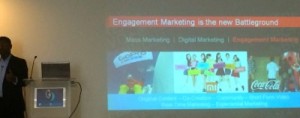Engagement & Innovation: The New Battleground in Marketing
 Insights from Brand2Global in London, October 1-2, 2014.
Insights from Brand2Global in London, October 1-2, 2014.
Last week, I shared my excitement at seeing big brands like LEGO, Google and Nike meeting at Brand 2 Global 2014 to strategize about content marketing and social media around the world.
Well, I’m still excited and want to share a few more insights from some of the excellent speeches during the conference.
Lenovo: rags to riches
Engagement marketing is the new battleground, according to Ajit Sivadasan, VP/GM Global eCommerce and Marketing at Lenovo. And he should know. Lenovo is an incredible success story, going from being a relatively unknown company to one of the world’s largest computer retailers.
Ajit’s insightful presentation highlighted the fact that having a huge marketing budget isn’t necessarily going to make you successful. Success is about engaging the right customers and providing them with content which is useful and relevant.
 I would personally add one piece of advice to Ajit’s rightful insistence on engagement marketing: influence marketing helps to accelerate customer engagement. The battleground should be fought on both fronts—engagement and influence—in order to get the most out of your content creation and social media efforts.
I would personally add one piece of advice to Ajit’s rightful insistence on engagement marketing: influence marketing helps to accelerate customer engagement. The battleground should be fought on both fronts—engagement and influence—in order to get the most out of your content creation and social media efforts.
Accenture: innovate or perish
“Innovate or Perish: Implications for Global Brands”—a brilliant title for a killer presentation by Kevin Carl, MD of Accenture USA.
So many big companies perished when they lost their mojo for innovation. RIP Kodak, Trans World Airlines, Blockbuster, Saab, Pan Am… On the flip side, four of the world’s five largest companies by market share are digital—Microsoft, Apple, Google, Facebook. The fastest growing companies are highly disruptive and invest heavily in platform technology. Companies like Apple with their App Store, Uber with their chauffeur app, and AirBnB with their “user review” approach to booking lodging, all bring amazing agility from the back end.
Interestingly, Kevin used one of our clients, Marriott, as a case study. We’ve been working with Marriott on several content creation and social media projects, and it’s no surprise to learn that the brand was named as being among the top 20 innovative companies in the world. What’s behind the success? Innovation.
Innovation in social media, marketing and branding has helped Marriott morph from being an old-school hotel chain into one of the coolest brands in the world. Content marketing is at the core of their strategy to connect with new customers and build relationships during the booking process. Evidence: they’ve just opened a brand new in-house content creation studio. They “invest close to their guests” in new and exciting ways, particularly in the field of mobile marketing.
This is what engagement and innovation are all about. And it’s a refreshing change from three years ago when hotel companies had no understanding of—or interest in—developing a global content strategy.
Content marketing + data = success
Kevin also backed my feeling that data scientists and content marketers are going to work together ever more closely to find better ways to engage with their communities.
Data-driven content marketing is coming our way, and this is a space in which marketers can really innovate.
No doubt it was data that persuaded Accor, one of EVG’s largest customers in Europe and an agile and innovative global content marketer, to move its Luxury brand headquarters to Singapore. When a French hospitality brand moves its Luxury decision-making center to Asia, that tells you something: that the data on the rise of Asian markets is too powerful to ignore.
Digital marketers and advertisers are now, thanks to big data, understanding that quality content is not only about attracting traffic to a website. It is also about branding, loyalty, credibility… and, ultimately, conversion rate.
The relationship between content and conversion rate is not complicated. When customers have all the information they need at their fingertips—and that information is engaging, well organized and easily searchable—they’re more likely to book or buy.
Western Union: customers deserve quality
German is German, right? Not according to Stefan Zechner, Assistant Marketing Manager at Western Union, who gave the conference audience insights into the company’s granular approach to content creation and translation. Germans, Swiss and Austrians deserve to have content in the language they speak day to day. So the company uses different German words, tones and phrases depending on whether they are targeting Germany, Switzerland or Austria. This is done offline as well as online, and is a great example of a creative, local approach to content marketing.
Clearly, with 500,000 retail outlets in over 200 countries, Western Union has understood from early on the need for high-quality original content and translation. Machine translation, or copy written by inexperienced and unedited writers, damages a brand’s reputation. Only quality content helps Western Union build the trust and credibility it needs to do business in so many communities around the world.
Eager for more insights?
Watch the EnVeritas Group Slideshare page for an overview of the panel I moderated on Global Content Marketing, which included experts Frank Hartkopf of Axonn Media, Stefan Zechner of Western Union and Antoine Dubois, VP of Advertising and Communication at Accor.
You can also check out the Brand2Global website, where presentations and speaker interviews will be released over the next couple of weeks.
Eric Ingrand – VP Content Marketing EMEA



